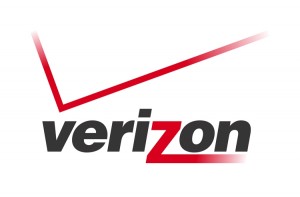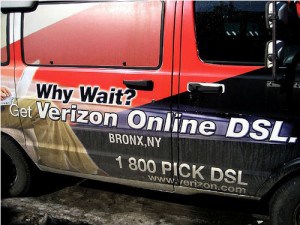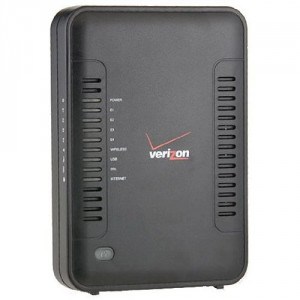Customers Accuse Verizon of “Optimizing” Down DSL Speeds to Reduce Expensive Upgrades, Service Calls
 An increasing number of Verizon’s DSL customers are discovering their broadband speeds cut, sometimes significantly, by the phone company’s internal line testing “optimization” tool, designed to deliver stable DSL service over a deteriorating, aging network of copper phone lines.
An increasing number of Verizon’s DSL customers are discovering their broadband speeds cut, sometimes significantly, by the phone company’s internal line testing “optimization” tool, designed to deliver stable DSL service over a deteriorating, aging network of copper phone lines.
Regular Stop the Cap! reader Smith6612, who is extremely familiar with the technical workings of DSL service, dropped us a note to report a disturbing trend of complaints from Verizon customers who are waking up to speed cuts that often don’t make sense.
At issue here is the highly variable nature of DSL speed and how providers manage it for customers. Data delivery over America’s aging copper wire, meant-for-voice-calls-network has always been somewhat of a bootstrapped affair, all the way back to the days of dial-up. Most phone companies have always included detailed disclaimers for customers relying on a phone network envisioned more than 100 years ago for 21st century data communications. No guarantees on speed or access are among the most common, especially with DSL service which is highly distance and line quality sensitive.
In short, the further away you live or work from the phone company’s exchange (where your individual phone line eventually ends up), the lower the speeds that line can support, if it can support DSL service at all. Badly managed wiring along the way can dramatically reduce the quality of your service. Sammy the Squirrel could chew enough insulation off a phone cable to expose it to interference from radio signals. Water finding its way into cables and connection boxes can turn excellent DSL service into no service at all during bad weather. Even temperature variations between seasons can eventually corrode, degrade, or destroy fittings, connectors, or any number of vital components necessary for good service.
Unfortunately, if companies do not properly invest resources to maintain their legacy phone networks, service problems are bound to increase sooner or later.
Many DSL customers do not really have an understanding of what speeds they should be getting from their providers, much less be able to easily identify when those speeds have declined. But they do understand service outages. When a DSL modem runs into trouble supporting the speeds it is configured for, the unit will try to re-establish the connection. This “sync” process can occur once a day or continuously — it all depends on what condition the line is in.
While this process is underway, anyone trying to use the Internet is likely to find their service unavailable. That often results in a service call.
 Calling to complain about a troublesome Internet connection is expensive — even when reaching one of the overseas call centers Verizon regularly uses for customer support. Sending a repair truck to your home is even more costly.
Calling to complain about a troublesome Internet connection is expensive — even when reaching one of the overseas call centers Verizon regularly uses for customer support. Sending a repair truck to your home is even more costly.
One way to reduce these expenses, without upgrading or improving maintenance of your network, is to simply reduce the speed of the connection.
Verizon ironically calls their line testing process “optimization.” Verizon’s software is designed to ascertain the maximum possible downstream and upstream speeds a line can continually support. Those measurements are used as a basis for configuring the customer’s modem, placing a speed limit on how fast of a connection to negotiate, even if a customer is paying for a faster tier of service. The goal is to stop the modem from losing a connection.
Unfortunately, sometimes customers with no service problems at all take a hit in speed along the way. For several weeks now, many long-standing Verizon DSL customers are discovering their speeds have been reduced and are finding Verizon’s “optimization” procedures directly responsible. Some are accusing Verizon of recently configuring connections more conservatively to avoid service calls caused, in part, by years of neglect maintaining their landline network.
Bob in North Billerica, Massachusetts has experienced a speed cut himself.
Writing on the Verizon DSL forum at Broadband Reports, he noticed years of stable service at 1.792Mbps/448kbps are no more. His maximum download speed has been cut to 1.5Mbps.
The same thing happened to Zaii in Philadelphia — despite stable service at higher speeds, he found himself cut back to 1.5Mbps as well.
Jack in Lakeland, Florida discovered his speeds has been “optimized” nearly in half by Verizon, and the company admitted it had capped his maximum speed as part of that process. He was paying for 1.5Mbps service and received 700kbps-1Mbps service.
“The technician [sent to my house] found I could receive 2.6Mbps but Verizon had me “optimized” at 1.2Mbps because of my location,” Jack writes. “The technician made a call and had the “optimize” cap removed and I am back to 1.54Mbps.”
It’s the same story in Ridgecrest, California where one Verizon DSL customer suddenly noticed a dramatic speed cut. He pays for 1.5-2Mbps service and barely manages 1Mbps these days. A Verizon technician thought even with the sudden speed loss, his speeds were still “pretty good.”
That attitude doesn’t exactly placate Verizon customers paying for more and receiving less.
Often, technicians sent to the home find their own line tests are far more optimistic about the speeds Verizon can support. The customer in Ridgecrest, for example, learned from a technician his line can support 3Mbps, but Verizon’s corporate “optimization” software says otherwise.
A few anecdotal reports from customers listening to Verizon field technicians suggests many of these issues are being caused by Verizon’s “optimizing” software. Once a service call commences, knowledgeable technicians manage to override the software settings and reset the connection back to support earlier, faster speeds. But often these changes last only a few weeks before the problem returns.
Unfortunately, Verizon’s customer service department usually seems unconcerned about speed complaints.
“SDillman” in Uxbridge, Massachusetts relayed his experiences:
I talked Verizon DSL support and got them to run a line test and they confirm the data rate they are seeing is 1.216Mbps, which is exactly what I reported. Unless it drops under 1Mbps they won’t do anything because it is considered an acceptable speed.
What stinks is that up until last week my data rate was a constant 1.792Mbps and all my speed tests showed 1.5Mbps. I even swapped out the modem today to try my backup and got the same rate. So I’ve lost 500k for no reason at all and there is nothing I can do about it. It wouldn’t be so bad if I never had it, but losing it just doesn’t sit right with me. I might be looking at alternate providers and or mediums of broadband in the near future because that just leaves a poor taste in my mouth.
Angry, motivated customers can wreak havoc on bad customer service practices, and SDillman managed to overcome Verizon’s speed throttles and shares advice for others in the same situation:
- Visit and register for an account on Broadband Reports. Then visit and post a message in the Verizon Direct Support forum. Those messages are kept private between you and a Verizon technical representative. They have enhanced skills and authority over the traditional offshore customer service people, and in the words of “SDillman,” “are amazing — after getting the runaround from everyone else, those guys had a proper repair ticket created in no time.”
- Carefully listen to the technicians that are sent to your home. The technician in Uxbridge was frustrated that his service visit revealed a line in what he called “pristine condition,” yet Verizon’s “optimization” speed throttle said otherwise and was directly implicated in the speed reduction. The frustration mounted when Verizon’s own employee encountered the same roadblocks Verizon’s customers do from overseas customer service agents. In this case, a call center employee attempted to explain the basics of how telephone lines work to a Verizon technician with over 30 years of experience. The technician also didn’t respond any better to arguments that 1.2Mbps was a good speed when the customer is paying for a higher level of service.
- Most of these issues are best resolved between a Verizon service technician and employees at the central office exchange serving your home or business. Encourage a direct service call and do not accept over-the-phone assertions about speed issues, particularly from call center employees a half-world away. If the problems go unresolved, a compliant about bad phone/broadband service filed with your state’s Public Service/Public Utilities Commission may bring about a higher level of response, even if broadband speeds are unregulated.
As SDillman shares, “For now my speeds are back up, until they ‘optimize’ the line again to try to free up some of the congestion on their crowded routers and begin stealing bandwidth [again]. I don’t know if this practice is illegal, but it certainly doesn’t pass the smell test. It feels a lot like going into a gas station and filling up your tank and then finding out 30% of it is water.”


 Subscribe
Subscribe




